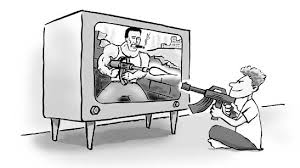Check out this weeks posts on our Twitter page
What Profanity or Violence did you see on TV this week?!?!!
TWEET at us and let us know!
FOLLOW US: @Comm398O1

While looking at violence on television, it is obvious that many people’s main focus is the way that it affects children. Many times on the news you see examples of violence being exerted in school such as the many school shootings that have happened throughout history and the most recent one being the stabbing that occurred on March 9, 2014. The fact that children and teenagers are some of the main people behind these acts is alarming due to the fact that they almost always have potentially seem themselves do these acts on a video game or something such as that.
In a study by Funk, Baldacci, Pasold, Baumgardner (2004) they talk about the use of video games as a way of “rewarding violence and desensitizing violence” (p. 25). Video games often reward violent behaviors in games and allow the user to feel a sense of accomplishment when they have done something bad to something or someone else. When it comes to real life situations, the users of these games may have felt themselves in charge of a weapon virtually, but now it is real in their hands and they may feel a sense of entitlement. The ability for someone to feel the reward of violence in their mind allows them to think that these feelings may come to them in real life due to their alter egos on gaming systems.
Although those who tend to use violence in the real world may not have gotten their exact motives and emotions from video games, the desensitization of the acts may have allowed them to think that these actions were reasonable. By censoring some violence on video games, it may allow the youth to feel less desire to enact violence such as the actions they perform during video games in real life.
Funk, J. B., Baldacci, H., Pasold, T., & Baumgardner, J. (2004, February). Violence exposure in real-life, video games, television, movies, and the internet: is there desensitization? Journal of Adolescence, 27(1), 23-39. Retrieved April 8, 2014, from http://www.sciencedirect.com/science/article/pii/S0140197103000939
Go check out this weeks posts and follow us on our twitter page!
FOLLOW US: https://twitter.com/Comm398O1
 Today in this world there is a high violence and aggressive behavior rate, and it’s continuously growing, from sexual assaults, school shootings, gang affiliations, and even war. There will always be good and bad in this world, but something’s are completely under our control. As parents, guardians, teachers, elders, babysitters, aunts, uncles, sisters, brothers, and more we have the ability to monitor what our youth is viewing in the media and on the television.
Today in this world there is a high violence and aggressive behavior rate, and it’s continuously growing, from sexual assaults, school shootings, gang affiliations, and even war. There will always be good and bad in this world, but something’s are completely under our control. As parents, guardians, teachers, elders, babysitters, aunts, uncles, sisters, brothers, and more we have the ability to monitor what our youth is viewing in the media and on the television.
In a study by The American Academy of Pediatrics on Media Violence the study was done to see the correlations between media violence and real life aggression in our youth. According to the study, “American children between 2 and 18 years of age spend an average of 6 hours and 32 minutes each day using media”. Children learn through imitating and doing behaviors of their own. Children under the age of 8 do not know the difference between real-life and fantasy, which can make a huge difference through their growth by what they are watching and how it is influencing them.
 According to the study, the strong correlation between media violence and aggressive behavior found is greater than that of calcium intake and bone mass, lead ingestion and lower IQ, condom nonuse and sexually acquired HIV, or environmental tobacco smoke and lung cancer. This shows how large the extent of children watching media violence can be.
According to the study, the strong correlation between media violence and aggressive behavior found is greater than that of calcium intake and bone mass, lead ingestion and lower IQ, condom nonuse and sexually acquired HIV, or environmental tobacco smoke and lung cancer. This shows how large the extent of children watching media violence can be.
 The National Television Violence Study evaluated that from 1995 to 1997 in just two years 61% of television was showing violence and portraying it in a glamorized manner. It also was the highest in children’s shows. The prolonged exposure of these shows grants acceptance to violence and creates the idea that it is appropriate to use violence in situations in order to get what you want in life. It is the growing youth of our country who is the future. The more violence a child watches, the more violence is what the world is going to see as a result.
The National Television Violence Study evaluated that from 1995 to 1997 in just two years 61% of television was showing violence and portraying it in a glamorized manner. It also was the highest in children’s shows. The prolonged exposure of these shows grants acceptance to violence and creates the idea that it is appropriate to use violence in situations in order to get what you want in life. It is the growing youth of our country who is the future. The more violence a child watches, the more violence is what the world is going to see as a result.
All content can be found on The American Academy of Pediatrics website under Media Violence. The link is listed below.
http://pediatrics.aappublications.org/content/108/5/1222.full.pdf
http://catholicfaithwarriors.blogspot.com/2013/01/television-is-mind-control.html
Affirmative Post